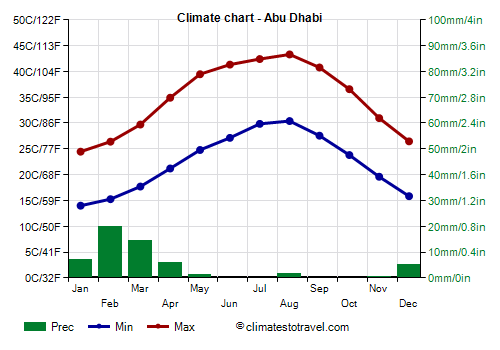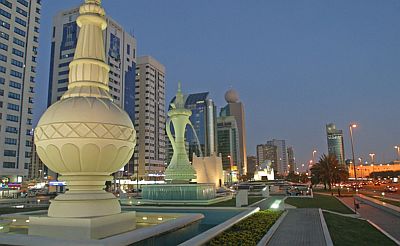Select units of measurement for the temperature and rainfall tables (metric or imperial).
Average weather, temperature, rainfall, sunshine
The United Arab Emirates (UAE) has a
desert climate, characterized by pleasantly mild winters and very hot, sunny summers, with the humidity of the Persian Gulf that makes the
heat unbearable.
Annual precipitation is almost everywhere below 100 millimeters (4 inches) and is concentrated in the winter months. The rains are rare, but they occur in the form of showers or downpours, which can sometimes be intense.
The country is made up of seven emirates, almost all overlooking the Persian Gulf (Abu Dhabi, Ajman, Dubai, Ras al-Khaimah, Sharjah, and Umm al-Quwain) and one overlooking the Gulf of Oman (Fujairah). The biggest emirate, which also includes the capital, is Abu Dhabi, even though the most famous one is
Dubai because of its futuristic buildings and modern tourist resorts.
In the northeast, in the
Al Hajar Mountains, which separate the coast of the Persian Gulf from that of the Gulf of Oman, the climate is still desert, although, in the winter months, it rains a bit more often than it does at sea level. Temperatures do not drop by much compared with the plain, except in the areas above 1,000 meters (3,300 feet), where it can get cold in winter, while in summer, the heat is more bearable.
The
south of the country, in the emirate of Abu Dhabi, is occupied by the vast sand desert called
Rub al-Khali, and is almost uninhabited except in the oases, such as that of Liwa, and near oil and gas extraction facilities. Here, the climate is similar to that of the coast, and it's even hotter in summer, but the air is drier because of the greater distance from the sea.
The climate in detail
The seasons
Winter, from December to February, is very mild or pleasantly warm: the maximum temperatures range from 24 °C to 26 °C (76 °F to 80 °F). Sometimes, especially in January, cool air masses from the north can bring some cool and windy days, during which the temperature can drop to around 10/12 °C (50/54 °F) at night and around 16/18 °C (61/64 °F) during the day.
Summer is very hot and sunny, with daytime temperatures ranging from 38 °C to 42 °C (101 °F to 108 °F) between May and September, and with the wind from the Persian Gulf that brings moist air from the sea, making the heat sweltering. April and October are also hot months, with highs around 33/36 °C (92/96 °F). During the hottest days, the temperature can reach 48/49 °C (118/120 °F) on the coast, and even more in the interior.
Luckily, buildings are air-conditioned.

All year round, but especially in spring, the United Arab Emirates may be affected by
strong winds, which can bring dust and sand storms.
Abu Dhabi

In Abu Dhabi, the capital, the daily average
temperature ranges from 19 degrees Celsius (66 °F) in January (so, we are at the boundary between the subtropical and the tropical climate) to around 37 °C (98.5 °F) in August.
In a typical year, only 55 millimeters (2.1 inches) of
rain fall, most of which occurring between December and March. In Dubai, still on the coast but more to the north, precipitation reaches 95 mm (3.7 in) per year.
The sun in the Emirates shines all year round, however, cloud banks may sometimes pass over the country, both in winter and in summer.

Sea temperature
The
sea in the Emirates is warm enough for swimming all year round, although it drops to 23 °C (73 °F) from January to March. In summer, it gets very warm, and it exceeds 30 °C (86 °F) from June to October, so as to allow long swims.
On the Gulf of Oman, the sea in winter is a bit warmer than in the Persian Gulf.
Tropical cyclones
Every now and then, the United Arab Emirates can be reached by
tropical cyclones, which bring strong winds and heavy rains, as happened with Cyclone Gonu in early June 2007, though it happens more rarely than in neighboring Oman.
The area most at risk is the northern one, and in particular, the emirate of Fujairah, which overlooks the coast of the Gulf of Oman; in contrast, the inland and western areas are generally spared.
Cyclones form from May to December, and are more frequent at the beginning of the period (May-June) and a little less at the end (October-December).
When to go
The best time to visit the United Arab Emirates is
winter, from December to February, which is a pleasant and sunny season, and which allows you to avoid the oppressive heat of the long warm season.
For a
beach holiday, the best months are March and November (with a preference for the latter because the sea is warmer), while in the long summer, when it gets too hot, even sunbathing can be a challenge.
What to pack
In
winter, pack light clothes for the day, a sweater and a jacket for the evening and for cool days, and a scarf for the wind.
In
summer, pack lightweight clothes, loose-fitting and made of natural fabric (cotton or linen), a desert turban, and a sweatshirt and a scarf for air-conditioned places. When going to the reef, you can bring snorkeling equipment, including water shoes or rubber-soled shoes.
It's better for
women to avoid shorts and miniskirts outside of tourist resorts.
Climate data - United Arab Emirates
| Abu Dhabi |
|---|
|
| Jan | Feb | Mar | Apr | May | Jun | Jul | Aug | Sep | Oct | Nov | Dec |
|---|
| Min temp. | 14 | 15 | 18 | 21 | 25 | 27 | 30 | 30 | 27 | 24 | 20 | 16 |
|---|
| Max temp. | 24 | 26 | 30 | 35 | 40 | 41 | 42 | 43 | 41 | 37 | 31 | 26 |
|---|
| Precip. | 10 | 10 | 15 | 5 | 0 | 0 | 0 | 0 | 0 | 0 | 0 | 10 |
|---|
| Prec. days | 3 | 2 | 3 | 1 | 1 | 0 | 1 | 1 | 0 | 1 | 2 | 2 |
|---|
|
|
| Sun hours | 8 | 9 | 9 | 10 | 11 | 11 | 11 | 10 | 10 | 10 | 9 | 8 |
|---|
| Sea temp | 22 | 21 | 22 | 25 | 29 | 31 | 32 | 33 | 33 | 31 | 28 | 25 |
|---|
| Al Ain (265 meters) |
|---|
|
| Jan | Feb | Mar | Apr | May | Jun | Jul | Aug | Sep | Oct | Nov | Dec |
|---|
| Min temp. | 13 | 14 | 17 | 22 | 26 | 28 | 30 | 31 | 28 | 24 | 19 | 15 |
|---|
| Max temp. | 25 | 28 | 31 | 37 | 42 | 45 | 45 | 45 | 42 | 38 | 31 | 27 |
|---|
| Precip. | 15 | 5 | 20 | 5 | 0 | 0 | 5 | 0 | 0 | 0 | 0 | 5 |
|---|
| Prec. days | 3 | 2 | 5 | 2 | 1 | 0 | 1 | 1 | 0 | 0 | 1 | 2 |
|---|
|
|
| Sun hours | 9 | 9 | 9 | 10 | 11 | 11 | 10 | 10 | 10 | 10 | 9 | 9 |
|---|
|
| Dibba Al-Fujairah |
|---|
|
| Jan | Feb | Mar | Apr | May | Jun | Jul | Aug | Sep | Oct | Nov | Dec |
|---|
| Min temp. | 17 | 18 | 20 | 25 | 29 | 31 | 32 | 31 | 29 | 26 | 22 | 19 |
|---|
| Max temp. | 25 | 26 | 29 | 34 | 39 | 39 | 38 | 36 | 36 | 34 | 30 | 27 |
|---|
| Precip. | 20 | 10 | 25 | 10 | 0 | 0 | 0 | 0 | 0 | 5 | 10 | 25 |
|---|
|
|
|
|
| Sea temp | 24 | 23 | 24 | 26 | 29 | 32 | 33 | 33 | 32 | 30 | 28 | 25 |
|---|
| Dubai |
|---|
|
| Jan | Feb | Mar | Apr | May | Jun | Jul | Aug | Sep | Oct | Nov | Dec |
|---|
| Min temp. | 15 | 16 | 19 | 22 | 26 | 29 | 31 | 32 | 29 | 25 | 21 | 17 |
|---|
| Max temp. | 24 | 26 | 29 | 34 | 38 | 40 | 42 | 42 | 40 | 36 | 31 | 26 |
|---|
| Precip. | 20 | 10 | 20 | 5 | 0 | 0 | 0 | 0 | 0 | 0 | 5 | 15 |
|---|
| Prec. days | 3 | 2 | 3 | 2 | 0 | 0 | 0 | 0 | 0 | 0 | 1 | 4 |
|---|
| Humidity | 61% | 59% | 55% | 47% | 42% | 48% | 49% | 47% | 52% | 54% | 56% | 61% |
|---|
| Day length | 11 | 11 | 12 | 13 | 13 | 14 | 14 | 13 | 12 | 12 | 11 | 11 |
|---|
| Sun hours | 8 | 9 | 9 | 11 | 11 | 11 | 11 | 11 | 10 | 10 | 9 | 8 |
|---|
| Sea temp | 23 | 22 | 23 | 26 | 29 | 31 | 33 | 33 | 32 | 31 | 28 | 25 |
|---|
| Fujairah |
|---|
|
| Jan | Feb | Mar | Apr | May | Jun | Jul | Aug | Sep | Oct | Nov | Dec |
|---|
| Min temp. | 17 | 18 | 20 | 25 | 29 | 31 | 32 | 31 | 29 | 26 | 22 | 19 |
|---|
| Max temp. | 25 | 26 | 29 | 34 | 39 | 39 | 38 | 36 | 36 | 34 | 30 | 27 |
|---|
| Precip. | 20 | 10 | 25 | 10 | 0 | 0 | 0 | 0 | 0 | 5 | 10 | 25 |
|---|
| Prec. days | 4 | 3 | 4 | 2 | 0 | 0 | 0 | 1 | 0 | 1 | 2 | 2 |
|---|
|
|
|
| Sea temp | 24 | 23 | 24 | 26 | 29 | 32 | 33 | 33 | 32 | 30 | 28 | 25 |
|---|
| Ras Al Khaimah |
|---|
|
| Jan | Feb | Mar | Apr | May | Jun | Jul | Aug | Sep | Oct | Nov | Dec |
|---|
| Min temp. | 12 | 14 | 16 | 20 | 24 | 27 | 30 | 29 | 26 | 22 | 18 | 14 |
|---|
| Max temp. | 25 | 27 | 30 | 36 | 41 | 43 | 43 | 43 | 41 | 38 | 32 | 27 |
|---|
| Precip. | 30 | 20 | 30 | 5 | 0 | 0 | 0 | 0 | 0 | 0 | 10 | 20 |
|---|
| Prec. days | 4 | 3 | 4 | 1 | 0 | 0 | 0 | 0 | 0 | 0 | 1 | 3 |
|---|
|
|
| Sun hours | 7 | 8 | 8 | 10 | 11 | 11 | 9 | 10 | 10 | 10 | 9 | 8 |
|---|
|
See also the
temperatures month by month